In the latest Bayfield Training webinar, Anna Rose and Natalie Bayfield presented: How Do We Design to Influence Customer Experience and Footfall? This was the second webinar covering Space Syntax and its applications, and a closer look at the topics that will be covered in the Spatial Layout and Retail Performance one-day course on the 17th of September.
City centres rely on customers having a positive experience in retail environments. They should be attractive, comfortable and safe to use. This webinar explains how design can influence customer experience and footfall. The customer experience can be analysed taking into consideration the different scales of urban context accessibility. The customer journey from arrival in the area to buying a product needs to be understood. This webinar is an introduction to several tools to study and optimise the performance of retail developments.
What is Space Syntax?
Space Syntax is a theory and set of tools for the analysis of the built environment, that was developed at The Bartlett, University College London in the late 1970s. Space Syntax Limited is the commercial spin-off, that provides creative expertise in architecture and urban planning. Operating worldwide, we combine global design experience with advanced digital technology. Our science-based and human-focused approach forecasts the social, economic and environmental impacts of development on the lives of people.
Context and location value
At the city scale, the spatial accessibility model of Cardiff highlights the hierarchy of the publicly accessible streets. The map shows the relative usefulness of the different streets for all possible origin-destination pairs in the city centre. This is a useful tool for understanding the strength of a location for a retail development.
The example of Cardiff City Centre shows how spatial accessibility values correlate with observed pedestrian movement. This correlation forms the basis of a predictive pedestrian movement model, which can be used to test design proposals.
This type of modelling and forecasting has been applied for the site of the St David’s Centre. The tool is useful for understanding the impact of different design options on project performance and local context. Therefore, it is useful for internal and external communication between different stakeholder discussions.
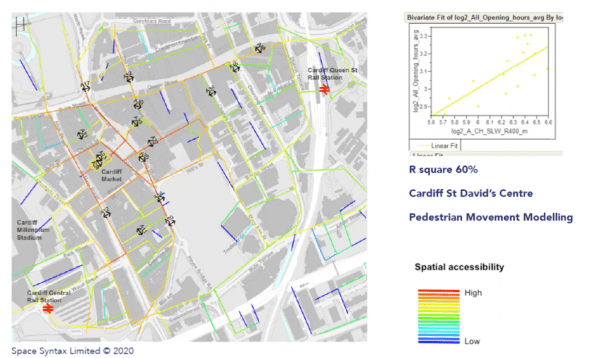
Figure 1 Context and location value
Retail performance at local scale – visibility
People like to go towards places they can see. More local spatial analysis of retail environments requires a good understanding of visual exposure. Strategic Visibility Analysis is used to model buildings and public spaces to highlight how visually- embedded different parts of a development are and can also be used for testing design interventions. This tool is based on the analysis of a grid of cells and calculates their relative strategic visibility. This measure has been associated with levels of visitor movement and stationary activity. Shopping centre managers typically want to achieve uniform visual exposure. Studies by Space Syntax have shown a correlation between strategic visibility and rent per sq. m.
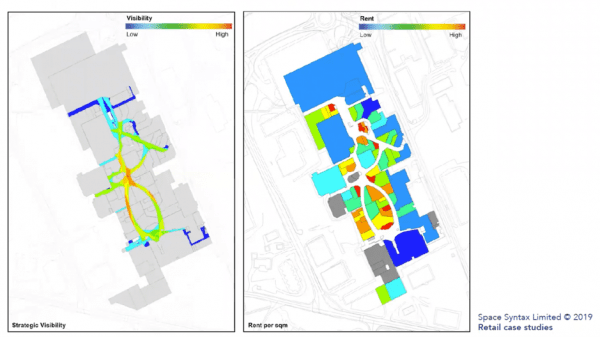
Figure 2 Visibility
Retail performance at local scale – optimisation
The case study of Sartor Storsenter is an example of using this technology to assist the design for the redevelopment of an existing shopping centre and its public realm.
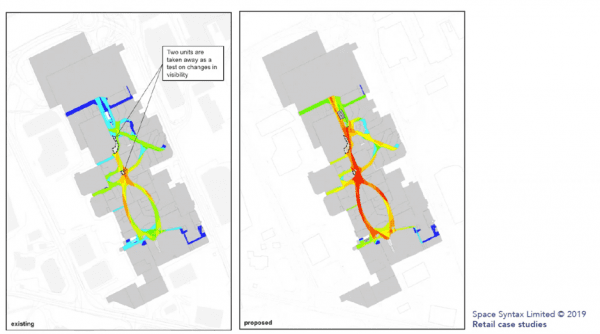
Figure 3 Optimisation
Understanding in-store experience – agent modelling
It is very important to understand the quality of the in-store customer experience to get the detailed design right. Different types of shops and products require a different kind of environment in terms of the level of passing footfall. Also, the circulation layout within a shop, as well as location and design of vertical circulation elements, need to be considered carefully.
Agent-based movement simulation is typically used in advanced stages of projects. It builds on spatial analysis, which informs the agents’ behaviour and provides them with visual information as they develop their path towards a destination. This visual intelligence is the main differentiator to other agent-based simulation tools. Outputs are also used to establish issues with distribution, capacity and comfort levels within confined spaces.
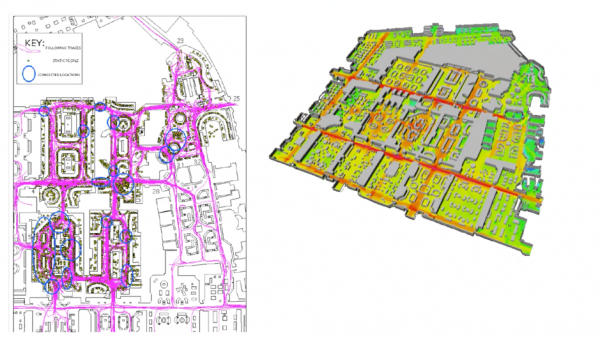
Figure 4 Agent-based modelling
Modelling customer experience – from city to object
What unites the tools discussed is that they can be used to understand and optimise the customer experience at the different stages of their interaction with retail environments.
The location and context can be studied using spatial accessibility analysis. Visibility analysis is helpful for optimising networks of open spaces and the design of developments. Agent-based modelling will inform more detailed analysis and design within developments and buildings, and their interaction with other generators of movement, such as large retail attractors, office buildings or transport interchanges.
Using spatial modelling and forecasting assists the design process that focusses on the user experience. It helps developers consider important investment decisions and supports crucial stakeholder negotiations.
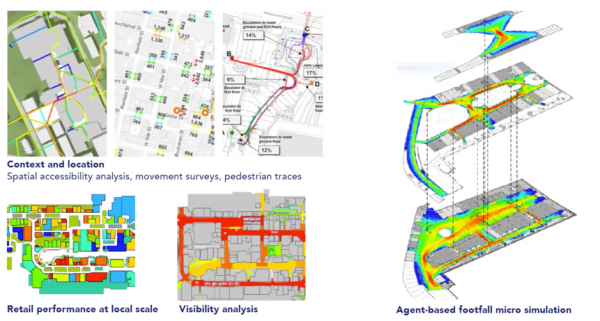
Figure 5 Space Syntax tools
To learn more about the topic of spatial layout analysis, design for cities and developments in a retail context, please register for our online course, ‘Spatial Layout and Retail Performance’ on the 17th of September.
Author: Sofia Hoch, Project Consultant at Space Syntax

